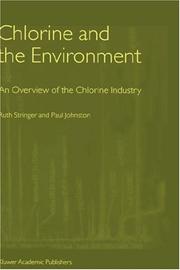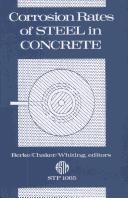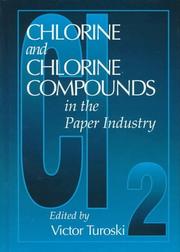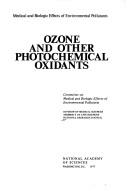| Listing 1 - 10 of 26 | << page >> |
Sort by
|
Book
ISBN: 9789176858134 Year: 2016 Publisher: Linkopings Universitet
Abstract | Keywords | Export | Availability | Bookmark
 Loading...
Loading...Choose an application
- Reference Manager
- EndNote
- RefWorks (Direct export to RefWorks)
This thesis investigates the cycling and distribution of chlorine in terrestrial environments, focusing on chloride ions and naturally occurring chlorinated organic compounds. It highlights the significant role of tree species in regulating levels of chlorine in soil, with coniferous forest soils showing higher chlorination rates compared to pasture and agricultural soils. The research explores the formation and degradation of chlorinated organic compounds and their impact on chlorine cycling, illustrating the dynamic equilibrium between chlorination and dechlorination processes. The study provides insights into the environmental factors influencing chlorine cycling, such as nitrogen presence, and emphasizes the potential risks associated with radioactive chlorine-36 present in the environment due to its long half-life and presence in radioactive waste. This information is vital for risk assessment and modeling of chlorine behavior in ecosystems.
Chlorine. --- Chlorine compounds. --- Chlorine --- Chlorine compounds

ISBN: 0792367979 Year: 2001 Publisher: Dordrecht Kluwer Academic
Abstract | Keywords | Export | Availability | Bookmark
 Loading...
Loading...Choose an application
- Reference Manager
- EndNote
- RefWorks (Direct export to RefWorks)
Chlorine compounds --- Chlorine industry --- Environmental aspects

ISBN: 0803114583 Year: 1990 Publisher: Philadelphia, Pa ASTM
Abstract | Keywords | Export | Availability | Bookmark
 Loading...
Loading...Choose an application
- Reference Manager
- EndNote
- RefWorks (Direct export to RefWorks)
staal --- corrosie --- Materials sciences --- Chlorides --- -Reinforcing bars --- -Chlorine compounds --- Halides --- Congresses --- Corrosion --- -Congresses --- Reinforcing bars --- Congresses. --- Chlorine compounds --- Corrosion&delete& --- Monograph
Book
ISBN: 354093393X Year: 1979 Publisher: Berlin : Springer-Verlag,
Abstract | Keywords | Export | Availability | Bookmark
 Loading...
Loading...Choose an application
- Reference Manager
- EndNote
- RefWorks (Direct export to RefWorks)
546.791 --- Uranium U --- 546.791 Uranium U --- Bromine compounds --- Chlorine compounds --- Iodine compounds --- Uranium compounds
Book
ISBN: 128228553X 9786612285530 0080922031 0123743737 9780080922034 9780123743732 Year: 2009 Publisher: London ; Boston : Academic,
Abstract | Keywords | Export | Availability | Bookmark
 Loading...
Loading...Choose an application
- Reference Manager
- EndNote
- RefWorks (Direct export to RefWorks)
The importance of chloride ions in cell physiology has not been fully recognized until recently, in spite of the fact that chloride (Cl-), together with bicarbonate, is the most abundant free anion in animal cells, and performs or determines fundamental biological functions in all tissues. For many years it was thought that Cl- was distributed in thermodynamic equilibrium across the plasma membrane of most cells. Research carried out during the last couple of decades has led to a dramatic change in this simplistic view. We now know that most animal cells, neurons included, exhibit a non-equili
Chloride channels. --- Chlorides --- Physiological transport. --- Chlorine compounds --- Halides --- Channels, Chloride --- Ion channels

ISBN: 1575040662 Year: 1998 Publisher: Chelsea Ann Arbor Press
Abstract | Keywords | Export | Availability | Bookmark
 Loading...
Loading...Choose an application
- Reference Manager
- EndNote
- RefWorks (Direct export to RefWorks)
Chlorine compounds --- Chlorine --- Papermaking --- Substitution (Technology) --- Wood-pulp --- Industrial applications --- Chemistry --- Environmental aspects --- Bleaching
Book
ISBN: 9241510617 Year: 1991 Publisher: Geneva WHO
Abstract | Keywords | Export | Availability | Bookmark
 Loading...
Loading...Choose an application
- Reference Manager
- EndNote
- RefWorks (Direct export to RefWorks)
Environmental Exposure --- Hazardous Substances --- Insecticides --- Hydrocarbons, Chlorinated. --- 615.9 --- 615.91 --- 614.878 --- 632.95.024 --- $?$92/08 --- Chemische stoffen --- Chlorine Compounds, Organic --- Organochlorine Compounds --- Chlorinated Hydrocarbons --- Compounds, Organic Chlorine --- Compounds, Organochlorine --- Organic Chlorine Compounds --- Chlorine Compounds --- prevention & control. --- toxicity. --- standards. --- Produits chimiques --- Chlorinated Hydrocarbon --- Organochlorine Compound --- Compound, Organochlorine --- Hydrocarbon, Chlorinated --- Hydrocarbons, Chlorinated --- prevention & control --- toxicity --- standards
Book
ISBN: 0080234410 1322299102 1483137503 9780080234410 Year: 1981 Publisher: Oxford: Pergamon,
Abstract | Keywords | Export | Availability | Bookmark
 Loading...
Loading...Choose an application
- Reference Manager
- EndNote
- RefWorks (Direct export to RefWorks)
Pesticides --- Organochlorine compounds --- Toxicology --- Physiological effect --- Toxicologie --- Effet physiologique --- -Organochlorine compounds --- -Pesticides --- -Chlorine organic compounds --- Organochlorines --- Chlorine compounds --- Organohalogen compounds --- Economic poisons --- Agricultural chemicals --- Pests --- Poisons --- Control --- Equipment and supplies --- -Toxicology --- Chlorine organic compounds

ISBN: 0309025192 Year: 1976 Publisher: Washington : National Academy of Sciences,
Abstract | Keywords | Export | Availability | Bookmark
 Loading...
Loading...Choose an application
- Reference Manager
- EndNote
- RefWorks (Direct export to RefWorks)
Chlorine --- Hydrochloric acid --- Toxicology --- Environmental aspects --- -Chlorine --- -Hydrochloric acid --- -Muriatic acid --- Spirits of salt --- Chlorine compounds --- Inorganic acids --- Muriaticum --- Oxymuriatic acid --- Halogens --- -Environmental aspects --- Muriatic acid --- Toxicology. --- Environmental aspects.
Book
ISBN: 9240686711 9789240686717 Year: 2002 Volume: 67 Publisher: Geneva : World Health Organization,
Abstract | Keywords | Export | Availability | Bookmark
 Loading...
Loading...Choose an application
- Reference Manager
- EndNote
- RefWorks (Direct export to RefWorks)
Chlorine dioxide (ClO2) exists as a greenish yellow to orange gas at room temperature. It is used in the paper and pulp bleaching industries as a sterilizing agent in hospitals as a biocide in water treatment and as an improving agent in flour.This document focuses on exposures via routes relevant to occupational settings principally related to the production of chlorine dioxide but also contains environmental information. The health effects and environmental fate and effects of chlorine dioxide used in the treatment of drinking-water together with those of halogenated organics produced by the
Chlorine Compounds -- toxicity. --- Environmental Exposure -- adverse effects. --- Risk --- Epidemiologic Measurements --- Oxygen Compounds --- Risk Management --- Environmental Pollution --- Anions --- Inorganic Chemicals --- Chemicals and Drugs --- Public Health --- Probability --- Ions --- Organization and Administration --- Statistics as Topic --- Health Services Administration --- Environment and Public Health --- Electrolytes --- Epidemiologic Methods --- Delivery of Health Care. --- Health Care Evaluation Mechanisms --- Quality of Health Care --- Investigative Techniques --- Analytical, Diagnostic and Therapeutic Techniques and Equipment --- Health Care Quality, Access, and Evaluation --- Risk Assessment --- Chlorine Compounds --- Environmental Exposure --- Oxides
| Listing 1 - 10 of 26 | << page >> |
Sort by
|

 Search
Search Feedback
Feedback About UniCat
About UniCat  Help
Help News
News